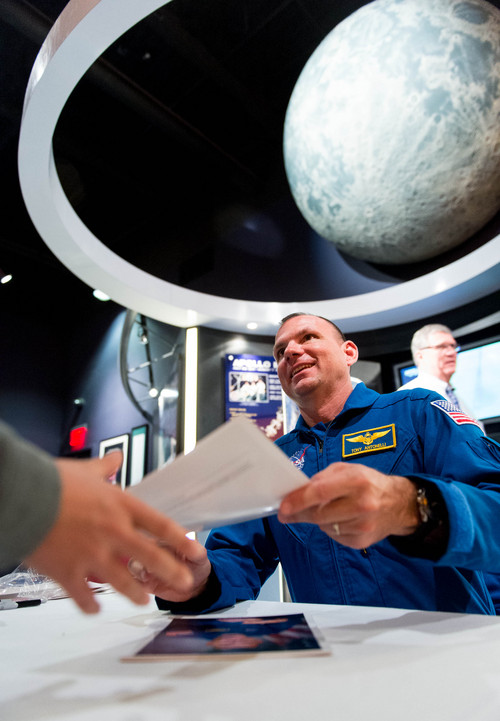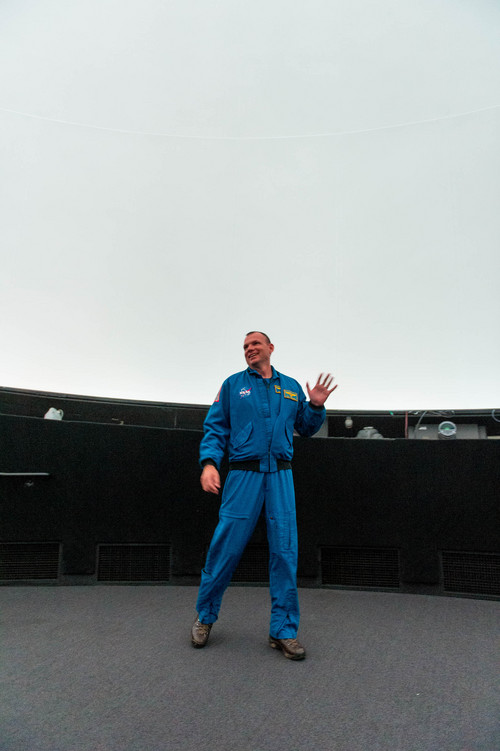This is an archived article that was published on sltrib.com in 2014, and information in the article may be outdated. It is provided only for personal research purposes and may not be reprinted.
Utah is once again at the center of spaceflight for NASA.
ATK, a Magna-based aerospace company, is creating the solid rocket boosters and the launch-abort system for the new Space Launch System, which is the replacement for the shuttle program and is scheduled to launch in December 2017.
Alex Priskos, NASA boosters manager for the SLS, and astronaut Tony Antonelli have spent the past two days talking with Utah college and elementary school students and the community about the new spacecraft. They were on hand Thursday morning at Clark Planetarium to officially open the new ATK exhibit that details the Utah company's work on the rockets needed for the SLS.
The new boosters have five stages — one more than the shuttle — and offer 3.5 million pounds of thrust, a 25 percent increase. The larger rockets allow the craft to heft heavier loads into space, and the design of the SLS also allows for a bulkier payload. In the shuttle, the largest diameter for cargo was 5 meters, and that will be increased to 10 meters in diameter and 130 feet in length.
While ATK and NASA are repurposing the solid rocket boosters used for the shuttle to cut down on costs, ATK is taking on a new aspect of the rockets — avionics. The company for the past seven or so years has recruited a team that can put together the brains of the rocket, overseeing issues ranging from steering to ensuring proper booster separation from the main rocket after leaving Earth's gravity well.
Charlie Precourt, who flew four shuttle missions for NASA and is now the vice president and general manager of ATK's Space Launch Division, said ATK is proud to take on a new aspect of the rocketry needed for space exploration.
"It's a delicate and challenging task," Precourt said, "and we've been excited to move into that area to create a strong product that is cost-effective, as well."
The new rockets are versatile, geared for missions to the moon, Mars, Jupiter's moon Europa, asteroids and other deep-space areas.
The initial craft will be able to carry a payload of 70 tons and stands at 320 feet. It is designed for missions to the moon and other nearby locations. For deep-space areas such as Mars and beyond, a later variation with a larger liquid-fuel upper stage rocket is planned and will carry a payload of 130 tons and stand at 400 feet, Priskos said.
Eventually, the program hopes to send between four and six astronauts at a time in the Orion capsule, which sits on top of the rockets. But sending humans into deep space has its own issues, such as handling radiation exposure, creating long-term life-support systems and finding ways to communicate with Earth. While it takes only about a second to get a message from Earth to the moon, it can take anywhere from 8 to 25 minutes to get a message one-way to Mars — depending on where the planet is in its orbit — and the same amount of time to get one back.
"I'm as homegrown as they come, and this mission gives me a different appreciation of pioneers," said Priskos, who grew up in Salt Lake City's Sugar House neighborhood, and earned his undergraduate degree from the University of Utah and a master's degree from Utah State University. "It gets back to the question of communication, and the pioneers weren't able to communicate with the people who were back in the places they came from, and our astronauts won't have that security blanket either."
Antonelli's role in the SLS project is to give operational knowledge to the engineers — basically pointing out what difficulties arise when piloting rockets, and working with engineers to find ways around those problems.
"It's a long way to be from home if you don't have everything you need with you," Antonelli said.
In addition to designing the solid rocket boosters, ATK is also creating the launch-abort motor. The feature is new on this rocket, and it allows the crew, located in the Orion capsule on top of the 300- to 400-foot rocket to escape if there is an emergency at launch or during ascent.
"Safety is different from risks, but we study all the risks as much as possible and put in mitigations," Precourt said. "Spaceflight is never perfectly safe, but neither is driving your car. We learn from what we've done in the past and make it absolutely as safe as possible."
Twitter: @sheena5427





